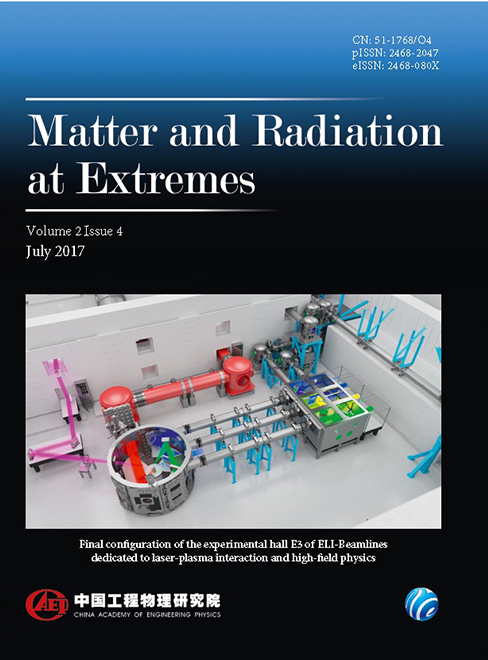
Fast Z-pinches, plasma implosions driven by MA-level ~100-ns duration current pulses, are an active research area with applications to a broad range of High Energy Density Physics studies, including investigations of properties of materials at extreme pressures,1 opacities of various plasmas at conditions found in stellar interiors,2 and scaled modelling of astrophysical magnetohydrodynamics.3 The ability of fast Z-pinches to generate extremely bright pulses of X-ray radiation is of significant interest for Inertial Confinement Fusion (ICF) studies. The highest X-ray powers and yields are achieved using wire-array Z-pinch loads, which are capable of generating 2-MJ, 250-TW,<10-ns X-ray pulses at the largest currently operating pulsed power facility, the 25-MA Z machine at Sandia National Laboratories (New Mexico, USA). The physics of wire-array loads continue to attract significant interest from the Z-pinch community, with research aiming to further improve their operation.
With the continuous development of high power laser technologies, lasers with peak power at 10 petawatt (PW) or above are becoming available soon in a few laboratories worldwide. Such lasers may be focused to an intensity above 1023 W/cm2, at which heavy elements such as uranium can be stripped of electrons, entirely leaving behind pure atomic nuclei, and electrons can be accelerated to more than 10 GeV. We are entering an unprecedented regime of laser-matter interactions, where collective effects, relativistic effects, and quantum electrodynamic (QED) effects all play significant roles. Extremely rich nonlinear physics in this regime could be tested experimentally, such as radiation reaction, gamma-ray and pair production via different processes, laser driven nuclear physics, laser-vacuum polarization, etc. It is expected that the new understanding of physics for these extreme high field conditions will lead to a wide range of applications.
The world is now applying a number of new facilities, advanced computing, and scientific insights to explore a variety and depth of phenomena that do not occur naturally on Earth. High power and high intensity lasers, z-pinches, and ion beams allow for laboratory investigations of material and radiation at extreme conditions in detail. The variety and depth of phenomena is beyond what most of us imagined, and scientists are eagerly considering what more can be found. This special issue illustrates the broad variety of physical phenomena under investigation.
62,64Cu are radioisotopes of medical interest that can be used for positron emission tomography (PET) imaging. Moreover, 64Cu has β? decay characteristics that allow for targeted radiotherapy of cancer. In the present work, a novel approach to experimentally demonstrate the production of 62,64Cu isotopes from photonuclear reactions is proposed in which large-current laser-based electron (e?) beams are generated from the interaction between sub-petawatt laser pulses and near-critical-density plasmas. According to simulations, at a laser intensity of 3.4 × 1021 W/cm2, a dense e? beam with a total charge of 100 nC can be produced, and this in turn produces bremsstrahlung radiation of the order of 1010 photons per laser shot, in the region of the giant dipole resonance. The bremsstrahlung radiation is guided to a natural Cu target, triggering photonuclear reactions to produce the medical isotopes 62,64Cu. An optimal target geometry is employed to maximize the photoneutron yield, and 62,64Cu with appropriate activities of 0.18 GBq and 0.06 GBq are obtained for irradiation times equal to their respective half-lives multiplied by three. The detection of the characteristic energy for the nuclear transitions of 62, 64Cu is also studied. The results of our calculations support the prospect of producing PET isotopes with gigabecquerel-level activity (equivalent to the required patient dose) using upcoming high-intensity laser facilities.
Recent achievements in laboratory astrophysics experiments with high-power lasers have allowed progress in our understanding of the early stages of star formation. In particular, we have recently demonstrated the possibility of simulating in the laboratory the process of the accretion of matter on young stars [G. Revet et al., Sci. Adv. 3, e1700982 (2017)]. The present paper focuses on x-ray spectroscopy methods that allow us to investigate the complex plasma hydrodynamics involved in such experiments. We demonstrate that we can infer the formation of a plasma shell, surrounding the accretion column at the location of impact with the stellar surface, and thus resolve the present discrepancies between mass accretion rates derived from x-ray and optical-radiation astronomical observations originating from the same object. In our experiments, the accretion column is modeled by having a collimated narrow (1 mm diameter) plasma stream first propagate along the lines of a large-scale external magnetic field and then impact onto an obstacle, mimicking the high-density region of the stellar chromosphere. A combined approach using steady-state and quasi-stationary models was successfully applied to measure the parameters of the plasma all along its propagation, at the impact site, and in the structure surrounding the impact region. The formation of a hot plasma shell, surrounding the denser and colder core, formed by the incoming stream of matter is observed near the obstacle using x-ray spatially resolved spectroscopy.
High-energy γ-photon generation via nonlinear Compton scattering and electron–positron pair creation via the Breit–Wheeler process driven by laser–plasma interaction are modeled, and a number of mechanisms are proposed. Owing to the small cross section, these processes require both an ultra-intense laser field and a relativistic electron bunch. The extreme conditions for such scenarios can be achieved through recent developments in laser technology. Photon emission via nonlinear Thomson and Compton scattering has been observed experimentally. High-energy positron beams generated via a multiphoton process have recently been observed too. This paper reviews the principles of γ-ray emission and e+e? pair creation in the context of laser–plasma interaction. Several proposed experimental setups for γ-ray emission and e+e? pair creation by ultra-intense laser pulses are compared in terms of their efficiency and the quality of the γ-photon and positron beams produced for ultrashort (15 fs) and longer (150 fs) multi-petawatt laser beams.
The use of plasmas provides a way to overcome the low damage threshold of classical solid-state based optical materials, which is the main limitation encountered in producing and manipulating intense and energetic laser pulses. Plasmas can directly amplify or alter the characteristics of ultra-short laser pulses via the three-wave coupling equations for parametric processes. The strong-coupling regime of Brillouin scattering (sc-SBS) is of particular interest: recent progress in this domain is presented here. This includes the role of the global phase in the spatio-temporal evolution of the three-wave coupled equations for backscattering that allows a description of the coupling dynamics and the various stages of amplification from the initial growth to the so-called self-similar regime. The understanding of the phase evolution allows control of the directionality of the energy transfer via the phase relation between the pulses. A scheme that exploits this coupling in order to use the plasma as a wave plate is also suggested.
High-energy electron radiography (HEER) is a promising diagnostic tool for high-energy-density physics, as an alternative to tools such as X/γ-ray shadowgraphy and high-energy proton radiography. Impressive progress has been made in the development and application of HEER in the past few years, and its potential for high-resolution imaging of static opaque objects has been proved. In this study, by taking advantage of the short pulse duration and tunable time structure of high-energy electron probes, time-resolved imaging measurements of high-energy-density gold irradiated by ultrashort intense laser pulses are performed. Phenomena at different time scales from picoseconds to microseconds are observed, thus proving the feasibility of this technique for imaging of static and dynamic objects.
Hydrodynamic instabilities such as the Rayleigh–Taylor (RT) and Richtmyer–Meshkov instabilities disrupt inertial confinement fusion (ICF) implosions through the growth of 3D perturbations. Growth of these 3D imperfections at the interfaces of an ICF capsule during implosion lead to mixing between materials that is detrimental to performance. These instabilities have been studied extensively in planar geometry, but such experiments lack the effects of convergence in spherical implosions. While several studies have been performed in spherical geometry, these often lack a direct means to measure perturbation growth. Experiments in cylindrical geometry include convergence effects while maintaining direct diagnostic access. Although cylinders have less compression than spheres, they do provide an excellent platform to validate modeling for convergent geometries. The problem with previous cylindrical implosion experiments was that the convergence ratios were limited to ~4. With the National Ignition Facility (NIF), larger cylindrical targets can be driven to convergences of 10–15 while maintaining a large enough final diameter to measure perturbation growth. This paper reviews the design process used to both benchmark radiation hydrodynamics codes and enable 1D post-processed simulations to explore design space to separate compression effects from acceleration/deceleration RT instability. Results from 1D simulations suggest that cylindrical implosions on the NIF can produce high-convergence experiments to validate RT instability growth for ICF implosions.
The cavity magnetron is the most compact, efficient source of high-power microwave (HPM) radiation. The imprint that the magnetron has had on the world is comparable to the invention of the nuclear bomb. High- and low-power magnetrons are used in many applications, such as radar systems, plasma generation for semiconductor processing, and—the most common—microwave ovens for personal and industrial use. Since the invention of the magnetron in 1921 by Hull, scientists and engineers have improved and optimized magnetron technology by altering the geometry, materials, and operating conditions, as well as by identifying applications. A major step in advancing magnetrons was the relativistic magnetron introduced by Bekefi and Orzechowski at MIT (USA, 1976), followed by the invention of the relativistic magnetron with diffraction output (MDO) by Kovalev and Fuks at the Institute of Applied Physics (Soviet Union, 1977). The performance of relativistic magnetrons did not advance significantly thereafter until researchers at the University of Michigan and University of New Mexico (UNM) independently introduced new priming techniques and new cathode topologies in the 2000s, and researchers in Japan identified a flaw in the original Soviet MDO design. Recently, the efficiency of the MDO has reached 92% with the introduction of a virtual cathode and magnetic mirror, proposed by Fuks and Schamiloglu at UNM (2018). This article presents a historical review of the progression of the magnetron from a device intended to operate as a high-voltage switch controlled by the magnetic field that Hull published in 1921, to the most compact and efficient HPM source in the twenty-first century.











